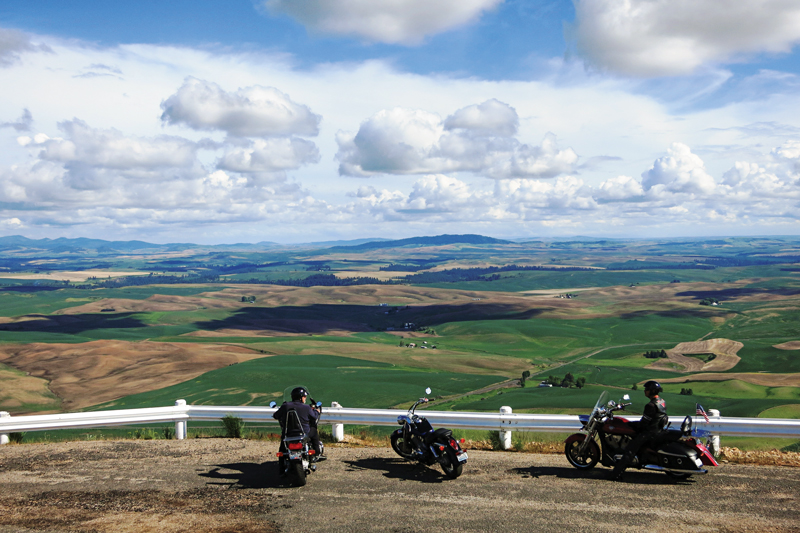
“The wheat field has…poetry,” Vincent Van Gogh once said. The muse the master painter found in wheat inspired dozens of his works. By the end of my recent tour through thousands of acres of the waving grain, I could see the wisdom of the one-eared post-impressionist.
I was the outsider, so I happily left the route planning to the native Washingtonians. My wife’s brother-in-law, Scott, and his brother-in-law, Dennis, discussed the riding merits of different roads leading to, and within, the Palouse region of eastern Washington. You’d think that any activity that begins with two mentions of “in-laws” could be destined for disaster. Not so in this case.

We enjoyed a great meal at Cow Creek Mercantile in the historic farming center of Ritzville. For what it’s worth, I enthusiastically recommend the delectable Kraut Runza. It’s a dish certainly inspired by the area’s heavy Volga German influence. We mounted up and headed northeast on our mixed bag of bikes. Dennis was piloting his red Victory, Scott was on his vintage Honda Gold Wing and I was riding a Shadow that was way out of my adventure bike comfort zone.
I settled into the low, feet-forward riding position as we rolled past the vibrant patchwork of wheat fields that are ubiquitous in the rolling hills of eastern Washington. There is a clear visual distinction between the vibrant, dense greens of the irrigated fields and the muted hues of the “dry” farms. Much of the region looks like a huge, non-geometrical, undulating checkerboard.

Our first stop on this Pacific Northwest adventure was the quaint farming town of Sprague. I flagged the others down when I spotted a cluster of vintage trucks and farm vehicles on the leading edge of town. With the kickstands down, we discussed the history of the place, and Scott informed me that there was an even more intriguing display of classic trucks on the other side of town. After a ride down Sprague’s brick building-lined 1st Street, his assessment proved true. I spent an inordinate amount of time amidst the patina-rich trucks strolling in a fascinating time warp.
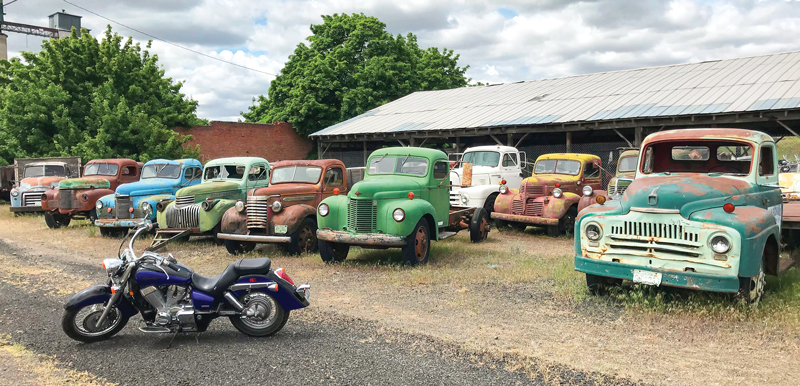
Back on the road, we headed southeast on State Route 23 deeper into the Palouse. The predominate theory of the region’s name is that it is derived from the name of a Native American tribe, the Palus, which was morphed by French traders with their word “pelouse,” meaning an expanse of land covered in thick grass. When riding the region, the French word certainly fits. We motored through gentle rolling hills and sweeping corners. The vivid blue sky cut a sharp demarcation above the green hues of the wheat fields and grasslands.

At the small farming town of Ewan, we again headed northeast. We stopped at Rock Lake, which to me simply looked like a prime fishing hotspot. However, my local riding companions said there was much more to this deep-blue body of water. It seems that Rock Lake is as mysterious as it is beautiful. There are legends of a sea monster in the cold depths of the lake that some local farmers swear is true. Then there is the story of a train wreck that dumped a load of brand new Model T Fords in Rock Lake a century ago. One thing is verified: the deep, cold lake seems to have a voracious appetite for careless anglers, as many have submerged never to return to the surface.
After several more miles of great riding through rolling wheat fields, we next stopped at a very cool farm equipment shop that had two huge tractors on sky-high poles. As we were discussing the next leg of the route, the owner (and engineer of the elevated sculptures) came out to the road to see if we needed help, and gave us directions on how to get to the centerpiece of our ride, Steptoe Butte. As he wiped the axle grease from his hands, he suggested a “winding” northern route that would add time, but also a new and different ecosystem including forests of evergreens. He had me at winding.
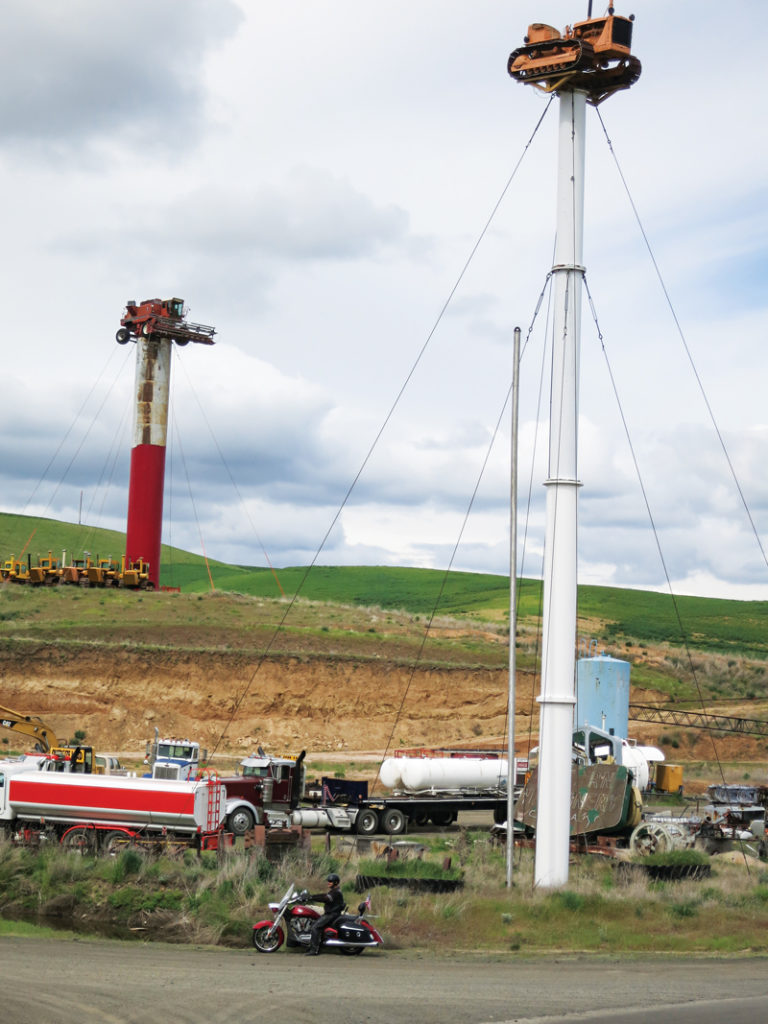
We climbed out of the farm and grasslands into the pines south of Spokane. The air was cooler, and the curves more serpentine. This forested stretch was not long, but it added another layer to a great ride. We took a turn to the southeast onto the Palouse Scenic Byway. Historic barns dotted the vibrant green grasslands that comingled with the muted hues of the wheat fields. On a couple of occasions, we had to pull over to make way for massive farm machinery navigating the narrow country roads, but other than that, the route was virtually devoid of four-wheeled traffic.
Later, from the saddle of his Gold Wing, Scott pointed out a swell in the rolling land that was larger than the rest. I concluded that it must be Steptoe Butte in the distance. As we rolled closer, the butte grew subtly in size, but it was not, I thought in the moment, as impressive as I anticipated. That would change as we started the ascent up its narrow road. The majesty of Steptoe Butte State Park comes on slowly and then grows exponentially with altitude.

Once on top of Steptoe, the views were staggering. That patchwork of greens and browns that we had ridden through were on expansive display in a full 360 degrees. Short walks across the summit parking lot afforded long perspectives in every direction. I was told that the view from the butte’s elevated position is about 200 miles. We were lucky enough to be there on a day with blue skies and bulbous clouds, which only added to the natural ambiance.
Steptoe Butte has a fascinating history. At the 3,612-foot summit, the State Park Service has erected some informative interpretative panels with some of the notable ecological and human influences on the area. The first primitive road up Steptoe was cut in 1888. That same year, James “Cashup” Davis completed a two-story, 50-room hotel at the top. Davis died in his hotel in 1896 at the age of 81. The hotel, which suffered a decline in visitors over the years, closed its doors forever in 1902 and burned in an accidental fire in 1911.
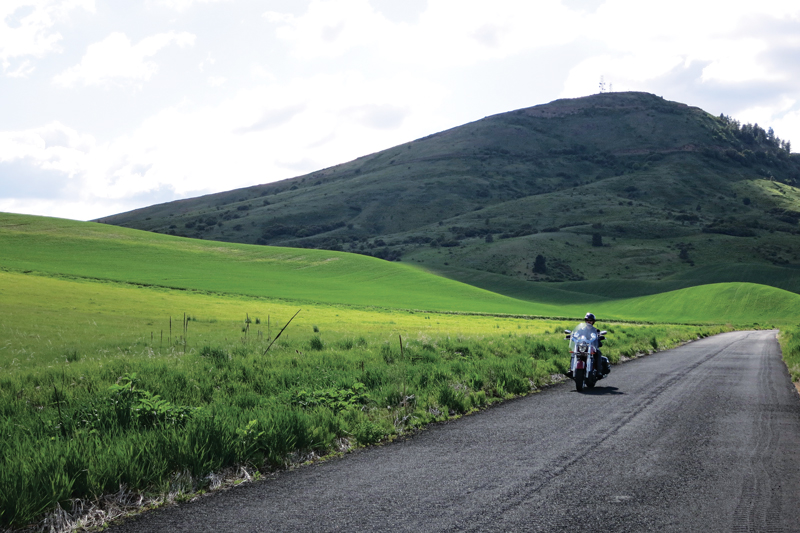
After taking in the views from Steptoe, we descended the narrow road back to the floor of the park, and then back onto the scenic byway. The entertaining curviness and undulation of the tarmac continued until we reached our next stop. We rolled into Colfax, which serves as the seat of Whitman County. Again historic brick buildings lined the long Main Street of the town.
We stopped at Eddy’s Chinese and American for some sustenance and to recount the ride to that point. My body was starting to feel the effects of the strange-to-me cruiser seating position, and the constant blast of wind on the unfaired Honda. The sweet and sour pork was tasty, and the conversation was lively as we shared the restaurant with farmers and locals.

With bellies full, we headed west toward our staging point of Ritzville. There were several more tiny farming communities dotting the return ride. We rolled through Endicott, Benge and Ralston. It is interesting to note that no matter how compact the communities in this region, each one has a massive grain silo as a centerpiece. Most also seem to have at least some display of historic farming machinery to pay tribute the region’s lifeblood. Wheat dominates the landscape, the lifestyle and the economy of most of eastern Washington.
My amiable and knowledgeable local guides had certainly traced a wonderful circuit through a fascinating part of the country. The region is unique in its expanse, its importance to the world food supply and its beauty. The natural contours of the Palouse are dressed in a coat of many colors, and the ribbons of tarmac that traverse those contours are a motorcycling playground. I will remember fondly the wide-open beauty of the Palouse. The wheat field certainly does have poetry.
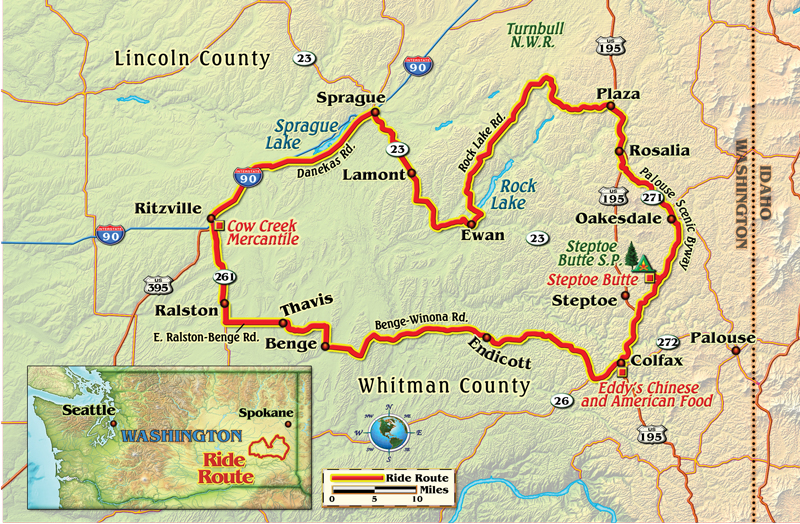









I AM A US CITISIN LEAVING IN TRENTON, ONTARIO, CANADA. I MARRIED A DUTCH-CANADIAN IN 2008 AFTER FINDING MY HUSBAND ON THE INTERNET AT 80 YEARS OLD. THIS IS A STORY IN ITSELF.
WHAT I WANT TO TELL YOU IS THAT I LIVED ON A PRODUCTIVE FARM 7 MILES EAST OF PALOUSE TOWN. I WAS BORN AND RAISED 10 MILES SOUTH OF PALOUSE AND AFTER MY HUSBAND THEN, WE LEFT THE MILITARY IN 1945 TO FARM AGAIN. I HAVE ALWAYS APPRECIATED THE BEAUTY OF THE LAND AND OFTEN WALKED THROUGH THE GRAIN. MY FIRST HUSBAND WAS A WELL KNOWN INVENTOR AND FARMER OF THE PALOUSE. I STILL REMEMBER THE HARVESTING AND COOKING FOR MEN AT 10:00 AT NIGHT. iT WAS OUR PAYCHECK SO WE DID NOT CRUMBLE WHEN WINTER CAME AND THE SNOW FELL BEGINNING THE LAST OF NOVEMBER. OUT CAME THE SKIS, WARM CLOTHING AND GETTING IN SHAPE FOR AS MANY A SKI RUN WE COULD MAKE. MT. SPOKANE AND SWITZER WERE OUR HOME BASES WHERE WE MET. AT THE TOP OF THE MOUNTAINS WE ENVISIONED THE SNOW CAPPED INLAND EMPIRE WHEAT FIELDS RESTING WITH NEWLY PLANTED WHEAT UNDERNEATH THE WHITE COVER. IN TRENTON I SEE NO MOUNTAINS AND THE FARMING IS VERY DIFFERENT AND MEANT MOSTLY FOR COWS AND CHICKENS TO EAT. YES, I MISS MY COUNTRY EMMENSELY AND AT ALMOST 93 I WAS PACKED AND READY TO GO BACK TO PROBABLY, COLFAX IN A RETIREMENT HOME. BUT THE CORNAVIRUS STOPPED MY DREAMS OF GOING BACK TO MY WHEATLANDS AND THE HONEST AND LOVING PEOPLE I MISS. HOWEVER THE WHEAT FIELDS ARE THERE BUT NOT ALL MY FRIENDS AS THEY ARE SLEEPING UNDER THE WHEAT FIELDS OR WHEREVER THEY GO.
Thank you for sharing your story! It made my day.
I’m lucky enough to live here and be able to ride this area. I consider myself extermely blessed!
I went up with some friends last week. I live near Cheney and went out through Turnbull and stopped at Rock Lake. So much history and beauty within our backyard.
Loved your story Frances!
I’m pretty sure that I have rode all of that route at different times. Some of my favorite riding is in southeast WA. Perfect for day rides from Spokane. Thanks for highlighting it!